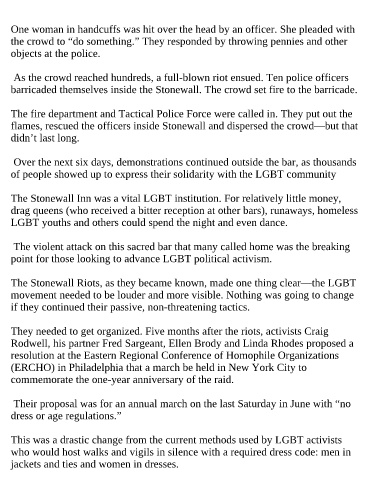Page 440 - ILIAS ATHANASIADIS AKA RO1
P. 440
One woman in handcuffs was hit over the head by an officer. She pleaded with
the crowd to “do something.” They responded by throwing pennies and other
objects at the police.
As the crowd reached hundreds, a full-blown riot ensued. Ten police officers
barricaded themselves inside the Stonewall. The crowd set fire to the barricade.
The fire department and Tactical Police Force were called in. They put out the
flames, rescued the officers inside Stonewall and dispersed the crowd—but that
didn’t last long.
Over the next six days, demonstrations continued outside the bar, as thousands
of people showed up to express their solidarity with the LGBT community
The Stonewall Inn was a vital LGBT institution. For relatively little money,
drag queens (who received a bitter reception at other bars), runaways, homeless
LGBT youths and others could spend the night and even dance.
The violent attack on this sacred bar that many called home was the breaking
point for those looking to advance LGBT political activism.
The Stonewall Riots, as they became known, made one thing clear—the LGBT
movement needed to be louder and more visible. Nothing was going to change
if they continued their passive, non-threatening tactics.
They needed to get organized. Five months after the riots, activists Craig
Rodwell, his partner Fred Sargeant, Ellen Brody and Linda Rhodes proposed a
resolution at the Eastern Regional Conference of Homophile Organizations
(ERCHO) in Philadelphia that a march be held in New York City to
commemorate the one-year anniversary of the raid.
Their proposal was for an annual march on the last Saturday in June with “no
dress or age regulations.”
This was a drastic change from the current methods used by LGBT activists
who would host walks and vigils in silence with a required dress code: men in
jackets and ties and women in dresses.

